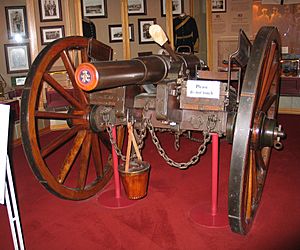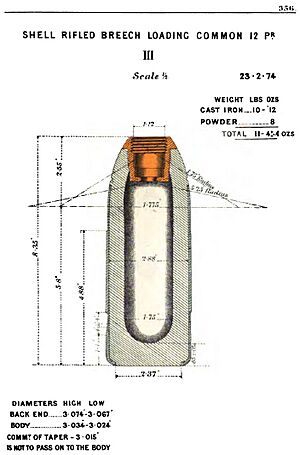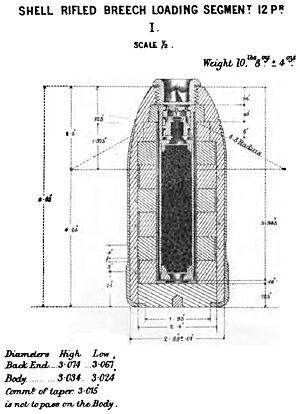RBL 12-pounder 8 cwt Armstrong gun facts for kids
Quick facts for kids RBL 12 pounder 8 cwt gun |
|
|---|---|

At the Australian War Memorial, Canberra
|
|
| Type | Field gun |
| Place of origin | United Kingdom |
| Service history | |
| In service | 1859–19?? |
| Used by | British Empire |
| Wars | New Zealand Wars Second Opium War |
| Production history | |
| Designer | W.G. Armstrong Co. |
| Manufacturer | Royal Gun Factory |
| Unit cost | £79 - £170 |
| Specifications | |
| Barrel length | First model: total 84-inch, bore 73.375-inch New model: total 72-inch, bore 61.375-inch (20.46 calibres) |
| Crew | 9 |
|
|
|
| Shell | 10 lb 11 oz Shrapnel 11 lb 4 oz common shell 10 lb 8 oz Segment 10 lb 9 oz case |
| Calibre | 3-inch (76.2 mm) |
| Breech | Armstrong screw with vertical sliding vent-piece (block) |
| Muzzle velocity | 1,239 feet per second (378 m/s) |
| Effective firing range | 3,400 yards (3,100 m) |
Imagine a super cool cannon from the past! The Armstrong Breech Loading 12 pounder 8 cwt was one of the first modern cannons. It was made in 1859 and was a 3-inch field gun. This means it was a type of cannon used by armies on battlefields. Later, it became known as the RBL 12 pounder 8 cwt.
Contents
How This Cannon Was Designed
This cannon had some really advanced features for its time. It was one of the first "breech-loaders." This means that the cannonball and gunpowder were loaded from the back end of the barrel. Older cannons were loaded from the front, or "muzzle." Loading from the back made the cannon fire much faster!
The cannonballs, called shells, were covered in lead. This lead helped them fit perfectly into special spiral grooves inside the barrel. These grooves are called "rifling." When fired, the rifling made the shell spin super fast as it flew. This spinning made the shell fly much more accurately and go much farther than older cannonballs.
The lead coating also sealed the gap between the shell and the barrel. This stopped gas from escaping when the gun fired, which used to be called "windage." Because of this, the cannon needed only half the amount of gunpowder compared to older cannons.
The barrel of the gun was made from a strong metal called wrought iron. It was built in layers: a main tube with more layers heated and shrunk over it as they cooled. This made the barrel extra strong and lighter than older cannons.
The Armstrong Gun in Britain
This cannon was the first rifled breech-loading field gun used by the British army. It replaced an older cannon from 1801. The first version of this gun had a barrel that was 84 inches long.
The Royal Navy, which is Britain's navy, used a shorter version. They simply cut 12 inches off the end of the barrel. From 1863, both the army and navy used this shorter, 72-inch version.
However, this new technology needed a lot of care and well-trained gunners. The British army wasn't quite ready for this, so the gun sometimes had a reputation for not working perfectly. Because of this, in 1871, Britain went back to using cannons that loaded from the muzzle. These older cannons were cheaper and used cheaper ammunition.
The Armstrong Gun in Australia and New Zealand
The Colony of Victoria, which is now the State of Victoria in Australia, sold six of these Armstrong cannons to New Zealand. They were used in the New Zealand Wars against the Māori people. These cannons, along with their equipment and ammunition, cost a lot of money back then. They traveled from Melbourne, Australia, and arrived in Auckland, New Zealand, in November 1863.
The Victorian Government bought six more cannons in 1864. One of these cannons has been fixed up and is now on display at the Australian War Memorial in Canberra. Another restored cannon is at the Sunbury War Memorial, and a third is at the Deniliquin RSL.
In New Zealand, these cannons were used in the New Zealand wars. For example, a group of six guns helped in the First Taranaki War in 1861. They were also used in the Second Taranaki War. Some cannons from Victoria were sent to help in January 1864. After the war, these cannons stayed in New Zealand and were used by the local army.
Types of Ammunition
The Armstrong 12 pounder could fire different types of shells. The "Common shell" was a basic explosive shell. The "Segment shell" was designed to break into many pieces upon impact, like shrapnel, to hit more targets.
Where You Can See Them Today
You can still see examples of these historic cannons in different places around the world:
- At the Australian War Memorial in Canberra, Australia.
- At the Te Awamutu Museum in Te Awamutu, New Zealand.
- At the Royal Artillery Museum in Woolwich, London, UK.
- At Fort Henry National Historic Site in Kingston, Ontario, Canada.
See also




